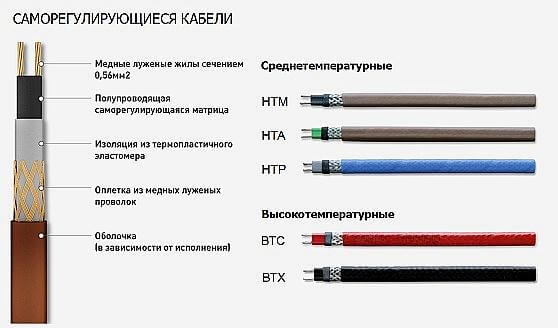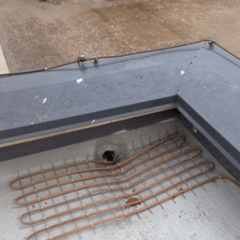Tips for choosing a heating cable
Self-regulating or resistive?
First you need to determine the type of heating conductor. Resistive cable is less practical because it has constant power and a fixed length. Among the disadvantages of this product, one can distinguish its tendency to overheat and fail. The main advantage is the relatively low cost. Learn more about how is the resistive cable You can from our article.
A self-regulating heating conductor has more advantages, so choosing it will be the right decision. The main advantages of the product: resistance to power surges, the possibility of saving electricity, there are no restrictions on the length of the heating system and, no less important, resistance to overheating. The only reason why the choice of a self-regulating heating cable is not always appropriate is a higher price (in some cases, a resistive wire is more appropriate, for example, for heating containers and pipes of small diameter).
Nevertheless, we believe that the right decision would be to choose a self-regulating heating cable, especially for heating the water supply system and the drain. Further, we will dwell in more detail on the selection criteria for this type of heating conductor.
Criterias of choice
So, the first thing you need to decide on is the design features of the product. Self-regulating heating cable design may include two copper conductors, a matrix, an insulation layer, a braid and an outer sheath. When choosing, be sure to pay attention to whether there is a braid on the thermal cable or not. If not, this is a budget option. Braid makes the wire strong, more resistant to mechanical damage and also grounded. Therefore, choosing this option will be the right decision.
You can learn more about the braid from the video:
Another important point is the type of external insulation. For domestic use (roof and gutter heating, sewage) it is quite enough to choose a heating cable with an insulating layer in the form of a polyolefin. If you want to use a cable heating system in production, and resistance to aggressive environments and ultraviolet radiation is important, we recommend choosing a thermal cable with fluoropolymer insulation. For water supply, if the conductor is laid in the pipe, it is better to choose a product with an outer shell of fluoroplastic.
Important! Not always the conductor, designed to heat pipes from the outside, can be used for laying inside. Check this point with the sales assistant!
The next thing you need to pay attention to when choosing a heating electric cable for the water supply and drainage is the temperature class. A low-temperature conductor can be heated up to 65˚C, while its specific heating power is not more than 15 W / m. This type of design is better to choose to protect small-diameter pipes from freezing. The medium temperature thermal cable heats up to a maximum of 120˚C and has a power of 10 to 33 W per linear meter. It is better to choose for gutters, pipes of medium diameter, as well as heating the roof. A high-temperature heating cable can reach a temperature of 190˚C with a specific power of 15–95 W / m. For a private house or a cottage, this type of execution is not suitable, its choice is rational for industrial conditions, heating pipes of large diameter.
Having become acquainted with the capacities and application of the thermal cable, the question arises, and what characteristics should the conductor have for a certain pipe diameter. So, we recommend choosing a heating cable, focusing on the following indicators:
- pipe diameter from 15 to 25 mm - power 10 W / m;
- 25-40 mm - 16 W / m;
- 40-60 mm - 24 W / m;
- 60–80 mm - 30 W / m;
- > 80 mm - 40 W / m.
Important!The choice of power of the heating cable must be approached responsibly. Insufficient power will lead to the fact that the heating system does not cope with its work, and overestimated indicators will negatively affect the energy consumption.
Well, the last thing I would like to advise is to pay attention to the product company. The best manufacturers of heating cable: Devi, Nelson, Raychem, Lavita, Ensto. Also, the domestic brand has established itself well - SST (Teplolux).
That's all I wanted to tell you about how to choose a heating cable for the water supply system and the drain. We hope our selection tips have been helpful to you!
We also recommend reading:










